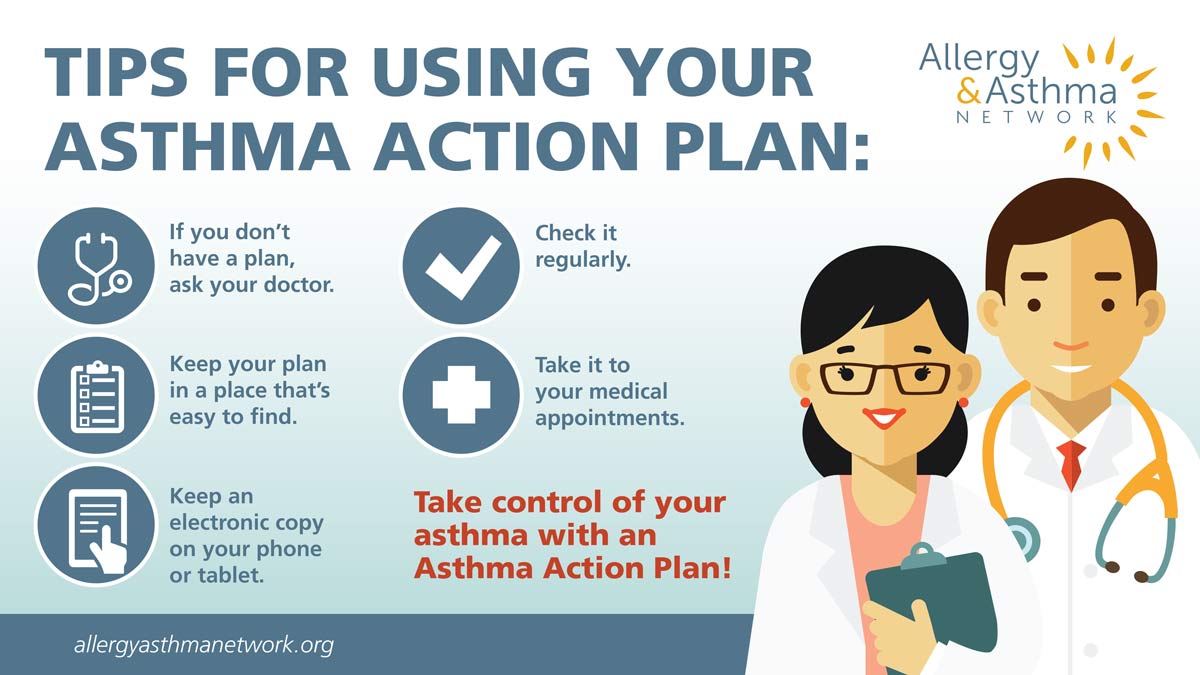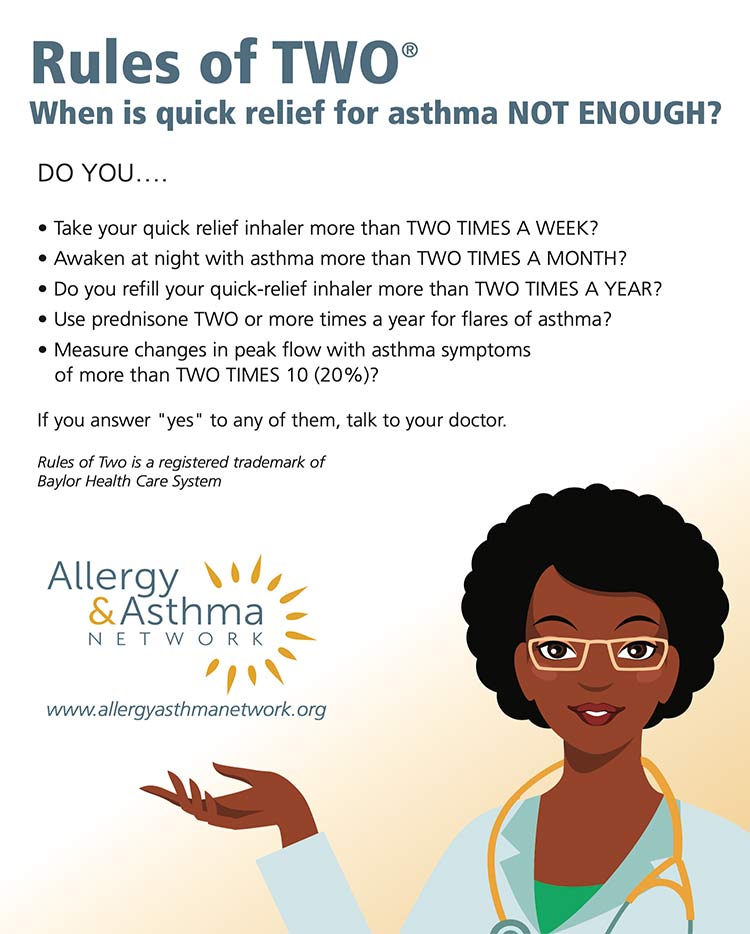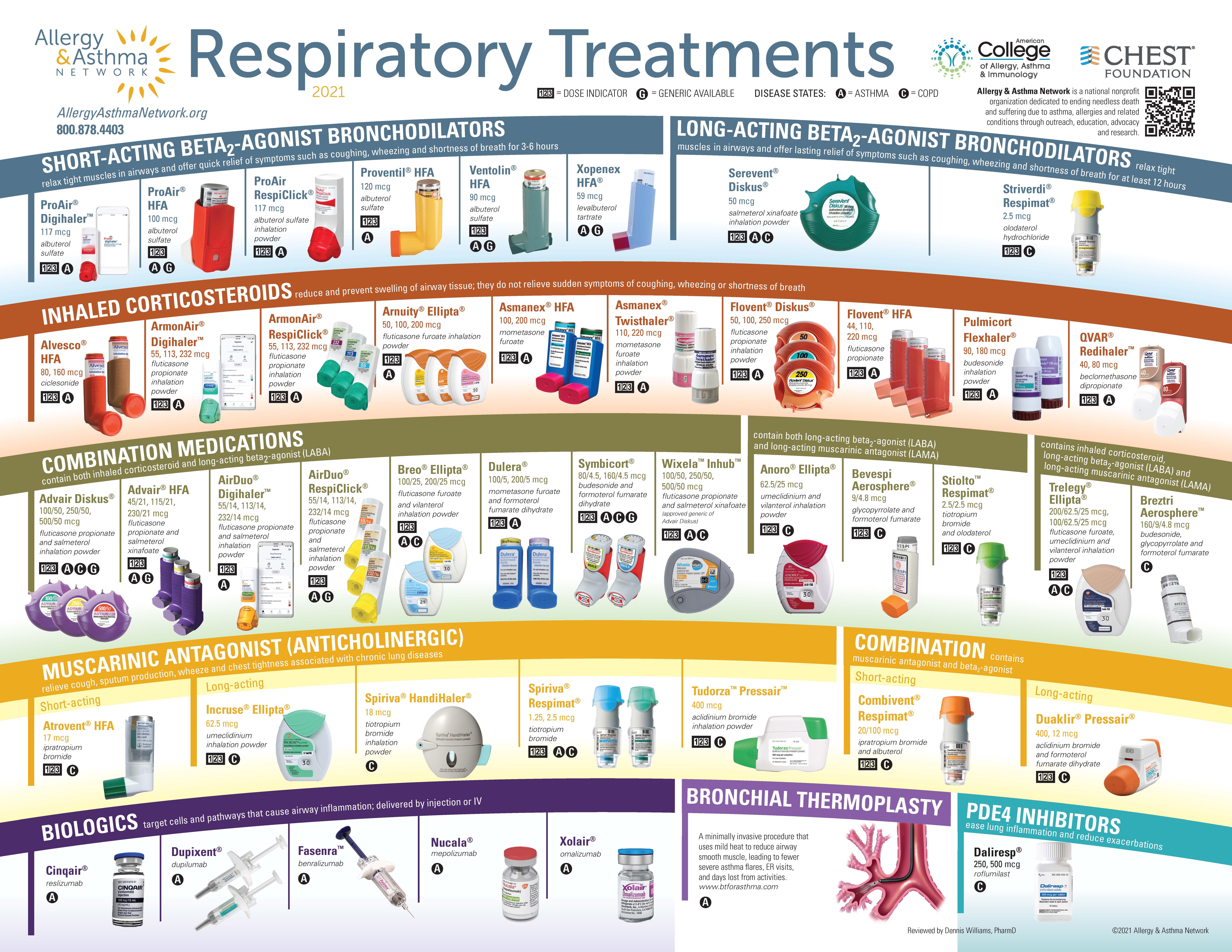Asthma is a chronic lung disease. There are 25 million people with asthma living in the United States. This includes 20 million adults and 5 million children. Asthma causes episodes of coughing, wheezing, chest tightness and shortness of breath. Symptoms can be mild or severe, and sometimes life-threatening. While asthma cannot be cured, understanding “what is asthma” and adhering to effective asthma treatment can lead to successful asthma management.
Treatment for asthma primarily focuses on managing symptoms along with preventing and treating asthma attacks. Different asthma treatments have different roles. It is important to understand your treatment and its roles in helping control your asthma.
Asthma treatment starts with knowing:
- Your asthma medications and how to use them correctly.
- Your asthma triggers.
- How to use your Asthma Action Plan.
- What asthma control is and what to do if it is not controlled.
Asthma medications
There are four basic types of asthma medicines:
- Bronchodilators relax and open the airways to relieve asthma symptoms.
- Controller medications (anti-inflammatory) are used to reduce and prevent lung inflammation.
- Combination inhaler medications combine more than one asthma medication in one device.
- Biologics are medications that target the specific cells and pathways that cause inflammation related to severe asthma.
Work with your healthcare provider to find the right combination of medications for optimal asthma control. You may need to adjust the type and amount of medication based on your symptoms, asthma test results, and the type of asthma you have.
Remember, the goal of asthma treatment is to have you feel your best with the least amount of medication needed to control asthma.
Bronchodilators
Bronchodilators relax and open the airways to relieve asthma symptoms. This helps with symptoms such as coughing, wheezing, chest tightness and shortness of breath. Bronchodilators can be both short-acting or long-acting.
What are the different types of bronchodilators for asthma?
- Short acting beta-agonist bronchodilators (quick relief): You may sometimes hear these referred to as short-acting beta-agonists, or SABA. These include albuterol and levalbuterol. With these quick-relief medications, symptom relief starts almost immediately and lasts 3-6 hours. This is the medicine you will be told to use if you are experiencing a sudden onset of symptoms or an asthma attack. Some people call quick-relief inhalers their “rescue inhaler” because it helps “rescue” you from the symptoms of an asthma attack.
At times, healthcare providers will prescribe quick-relief medications to prevent exercise-induced bronchospasm (EIB) – also called exercise-induced asthma. The quick-relief inhaler can be used 15-20 minutes before exercise to help prevent asthma symptoms.
- Long-acting beta-agonist bronchodilators: These medications relieve symptoms for 12 to 24 hours. You may also hear these referred to as long-acting beta-agonists, or LABA. Long-acting beta-agonists for asthma include formoterol, salmeterol, and vilanterol. They are typically used in combination with an inhaled corticosteroid.
- Long-acting muscarinic antagonist (LAMA): These are anticholinergic medications that are mostly prescribed for COPD, but a few are approved for severe asthma as well. Tiotropium and umeclidinium are approved for asthma and are typically used in combination with an inhaled corticosteroid.
Note: Always use inhaled corticosteroids as prescribed; do not stop using them even when you are symptom-free and appear to be well.
Controller medications
Anti-inflammatory medications treat and prevent airway inflammation and swelling. They also reduce mucus. These medications usually need to be taken every day to prevent and control symptoms. They are helpful with preventing asthma attacks.
After using an anti-inflammatory medication, you may not feel different right away. That’s because it takes time for airway swelling to subside and the mucus to clear out of the airways. Keep using the medication as directed, even if you don’t feel anything happening right away.
What are different types of controller medications for asthma?
- Inhaled corticosteroids (beclomethasone, budesonide, ciclesonide, fluticasone, mometasone) are effective long-term asthma control medications. Taken as prescribed, they can reduce excess mucus. They also prevent airway swelling. Because the medication is inhaled, the medicine goes directly to the inflamed airways.
Note: Always use inhaled corticosteroids as prescribed; do not stop using them even when you are symptom-free and feeling well. - Leukotriene modifiers are oral medications that block the action of leukotrienes. Common leukotriene modifiers include montelukast, zafirlukast, and zileuton. Leukotrienes are chemicals involved in immune system responses. These responses cause inflammation, swelling and tightening of the airways. They are available as granules, chewable or tablets. Leukotriene modifiers should not be used to treat sudden symptoms or asthma attacks.Montelukast may cause behavioral side effects. These may include sleep disturbances, anxiety, depression, confusion, sudden mood changes and suicidal thoughts or actions. Talk with your healthcare provider about these potential side effects before taking montelukast. If you’re prescribed it, monitor for side effects during treatment.
- Oral corticosteroids are used to treat acute asthma flares. They are usually prescribed only for short periods of time (5-7 days). Taken as prescribed, they gradually reduce asthma symptoms and open the airways.The dosage of oral corticosteroids is 10 times the dose of inhaled corticosteroids. As a result, there is an increased risk of side effects. These may include weight gain, insomnia, headaches, and easy bruising of the skin. Side effects may also include behavioral problems, moodiness and depression.If taking oral corticosteroids long-term, side effects can be even more problematic. Side effects from long-term use may include eye problems, onset of diabetes, increased risk of infections and thinning bones. Patients should talk with their doctor about the risks vs. benefits of long-term oral corticosteroid use.When you hear the term “steroids” in asthma care, they are referring to corticosteroids. These are NOT related in any way to the anabolic steroids used illegally in body building.
Combination medications
Combination medications combine two or even three medications into one inhaler. The devices may contain an anti-inflammatory inhaled corticosteroids, a SABA, LABA or LAMA. Combination medications are typically used daily.
What are different types of combination medications for asthma?
- Inhaled corticosteroids and LABA combinations: typically taken on a daily basis to control asthma symptoms. Most are taken once every 12 hours. One is taken once a day. These medication combos include budesonide/formoterol, fluticasone/salmeterol, fluticasone/vilanterol, and mometasone/formoterol.
- Inhaled corticosteroid, LABA and LAMA combination: there is one combination inhaler with these three medications approved for use in asthma. Medications in this inhaler include fluticasone/umeclidinium/vilanterol. It is typically taken once a day.
- SMART therapy: SMART stands for single maintenance and reliever therapy. It combines an inhaled corticosteroid and an inhaled LABA (formoterol) in one inhaler. This allows people with asthma to use a SMART therapy inhaler as a controller (maintenance) medication and for quick-relief for acute asthma symptoms.
-
SABA and inhaled corticosteroid combination: the medications in this inhaler are albuterol (SABA) and budesonide (an inhaled corticosteroid). The inhaler is used as a quick-relief inhaler. Since it includes an inhaled corticosteroid, it can also reduce airway inflammation. The inhaler is for the as-needed treatment of asthma symptoms caused by tightening of the airways. It can also help reduce the risk of an asthma attack.
Biologics
Biologic medications target cells, pathways and proteins that cause inflammation in the body. These medications focus on treating the source of symptoms rather than the symptoms themselves. They aim to stop symptoms before they can start by targeting inflammation in the body at its source.
Biologics are typically prescribed as an add-on therapy for severe asthma. This means you continue to take a daily controller medication in addition to the biologic.
Biologics are usually administered as an injection every 2 to 8 weeks. (One biologic is available as an infusion.) They are not used to treat asthma attacks. Biologics are intended to help patients gain long-term asthma control. They help improve asthma by reducing inflammation and the risk of an asthma attack.
What are different types of biologics for asthma?
- Anti-IgE biologics work to interrupt a protein (antibody) called IgE. This antibody is part of the allergic response to an allergen and the start of the inflammatory process. The medication in this category is omalizumab.
- Eosinophil reduction biologics work to decrease eosinophils (part of the white blood cell) in the body that promote inflammation. These medications include benralizumab, dupilumab, mepolizumab and reslizumab.
- TSLP (thymic stromal lymphopoietin) blockers work by blocking cytokines from starting airway inflammation. The medication in this category is tezepelumab.
What is bronchial thermoplasty?
Bronchial thermoplasty is an outpatient surgical procedure. It is for adults ages 18 and older with poor asthma control. These people have severe persistent asthma symptoms despite using standard therapy.
The procedure is performed in three outpatient visits under moderate or general anesthesia. A pulmonologist or other qualified physician inserts a long, slender tube called a bronchoscope into the lungs and surrounding airways. They then heat and shrink the size of muscle tissue. This allows more air to pass through and make breathing easier.
Side effects may include a short-term worsening of asthma symptoms. These side effects usually resolve within a week.
If you have severe and difficult-to-control asthma, talk with your doctor to determine if bronchial thermoplasty is right for you. Be sure to check your health insurance to confirm if the procedure is covered.
How are inhalers used to treat asthma?
Many asthma medicines are delivered using an inhaler or a nebulizer. Inhalers and nebulizers are devices that allow the asthma medications to be inhaled through your mouth. This means you breathe the medicine in, and it goes straight to the airways. There are four types of inhaler delivery devices:
- Metered-dose inhaler (MDI): pressurized devices that release medication in a fine spray for you to inhale
- Dry powder inhaler (DPI): releases medication as a fine powder for inhaling
- Breath-actuated Inhaler: a dry powder or a non-pressurized inhaler
- Slow-moving mist inhaler: similar to an MDI, but with a slower-moving mist
How are nebulizers used to treat asthma?
Nebulizers turn liquid asthma medicine into a fine aerosol. This allows the medicine to be deeply inhaled into the airways. Nebulizers are powered by a compressed air machine. They can be battery operated or plugged into an electrical outlet.
Studies show nebulizers are not more effective than MDIs. They do offer an alternative for patients. Nebulizers are helpful for those who may have difficulty with MDI coordination. They may also help someone who prefers a slower delivery of medication.
Some patients say they benefit from taking the extra time during an asthma attack for a nebulizer treatment. It gives them a chance to sit down, relax and breathe normally while the medicine relieves inflammation and bronchospasm.
Talk with your doctor or a pharmacist to find out if a nebulizer is right for you.
What is a holding chamber or spacer?
A valved holding chamber is a handheld device that attaches to a pressurized metered-dose inhaler (MDI). It captures the medicated mist as it sprays out. The medication is trapped long enough inside the holding chamber to be inhaled at your own speed. It also pulls out large particles of medication and prevents them from settling in your mouth or throat.
A spacer is like a valved holding chamber, but it does not suspend the medication. When using it, you must coordinate your breath to begin before actuating the MDI.
Holding chambers are available for use with and without masks. Masks are often essential for children, the elderly, and some disabled people. Anyone who cannot close their lips securely around the mouthpiece of the holding chamber should use a mask. Anyone who needs to take several breaths to inhale the medication fully should also use a mask.
How do I reduce the need for medications?
Sometimes asthma symptoms seem to come out of nowhere. Other times, you can predict them. You can make sense of this asthma rollercoaster by tracking when and how symptoms happen.
Learn the early warning signs of an asthma attack. If you know what to look for, you will notice when an asthma attack is developing. These signs will vary from one person to another. But it can be as simple as a tickle in the throat or chest, a sharp or sudden cough, or a feeling of extreme tiredness.
This is important because it takes less medication to stop symptoms from worsening than it does to treat a full-blown asthma flare-up. By the time you begin to cough or wheeze, your lungs are already congested and compromised. That’s why you need to pay close attention to the subtle signs.
Follow the asthma treatment plan prescribed by your healthcare provider and be aware of your triggers.
How understanding asthma triggers can help with treatment
Part of asthma management involves understanding your asthma triggers. An asthma trigger is something that can cause a flare-up or make your symptoms worse. For some people, an asthma trigger may be pollen. For another, it may be exercise or cold air. For someone else, it may be pet dander or dust mites. Some people find that respiratory infections, such as a cold, COVID -19 or the flu, trigger symptoms. Every person has different asthma triggers.
When you learn your asthma triggers, you’ll find ways to reduce your need for asthma medications. Notice your triggers in your home, work or school. Then try your best to avoid contact with them or plan for preventative treatment. To benefit from your medication, it must be taken at the right dose, at the right time and in the right way. Since there can be obstacles to any of these steps, review your Asthma Action Plan at every doctor’s visit. Demonstrate your inhaler delivery technique to be sure that you are taking medication correctly.
If your asthma symptoms persist, talk with your healthcare provider about the need to adjust your medications. Discuss any concerns over cost. Any barrier to accessing or using your medication can affect your asthma control.
How does an Asthma Action Plan help with treatment?
Asthma is a condition that requires constant attention. That’s why you need an Asthma Action Plan – a personalized treatment plan. It is important for disease control and it can help prevent asthma attacks.
If you don’t have one, make an appointment with your healthcare team to develop one as soon as possible. Your Asthma Action Plan will change as your asthma improves or worsens. Review the plan with your healthcare provider at every appointment and discuss whether your medications are working as prescribed.
How do I know if my asthma is under control?
If you start to regularly experience symptoms during everyday activities, visit an asthma specialist to discuss whether you need to adjust your treatment plan. Discuss any problems you may have controlling your asthma.
The Rules of Two®, Asthma Control Test™ (ACT) and The Asthma Impairment and Risk Questionnaire (AirQ®) are ways to find out if your asthma is under control.
Rules of Two®
If you answer “yes” to any of these questions, make plans to visit your asthma specialist:
- Do you need to use your quick-relief inhaler TWO or more times a week? (except to prevent symptoms before exercise)
- Does your asthma wake you up TWO or more times a month? (Nighttime symptoms are a sign of nocturnal asthma)
- Do you refill your quick-relief inhaler TWO or more times a year?
- Do you use prednisone TWO or more times a year for flares of asthma?
- Does your peak flow vary at more than TWO TIMES 10 (20%) from baseline when you have asthma symptoms?
The Rules of Two® is a registered trademark of the Baylor Healthcare System.
Asthma Control Test™ (ACT)
The Asthma Control Test is a 5-question Q&A that helps you and your doctor determine whether your asthma is controlled. The test asks:
- how often you have experienced symptoms in the past four weeks;
- how often you have needed your quick-relief albuterol inhaler in the past four weeks;
- what impact symptoms have had on your life and your ability to sleep in the past four weeks.
Share the ACT score with your healthcare provider as a starting point for a conversation about managing asthma. A Childhood Asthma Control Test* is also available.
Asthma Impairment and Risk Questionnaire (AirQ)
The Asthma Impairment and Risk Questionnaire assesses a patient’s asthma control. It comes in a “Yes/No” format and designed for adults and children ages 12 and older. The questionnaire asks if coughing, wheezing, shortness of breath or chest tightness have:
- bothered you and/or limited your activities (including exercise and social events) and ability to sleep in the past two weeks;
- caused you to use your quick-relief albuterol in haler in the past two weeks;
- caused you to take oral corticosteroids;
- caused you to go to the emergency department or hospital with symptoms
Share the AirQ score with your healthcare provider and begin a conversation about your asthma treatment.
How does your healthcare provider decide the best way for you to take your asthma medication?
Many different asthma medication options are available, including tablets, capsules, granules and syrups. There are also aerosols and powders that you inhale from a metered-dose inhaler (MDI), dry powder inhaler (DPI), breath-actuated inhaler, slow-moving mist inhaler or nebulizer. Attaching a valved holding chamber to a pressurized MDI allows patients to direct the medicine into the airways by holding it and inhaling at their own speed. Lastly, there are medications that are given by an injection and one is an infusion.
Healthcare providers prescribe treatments effective in disease control. They want treatments that are convenient for patients’ needs and lifestyles. Talk with your healthcare provider about your needs, preferences and lifestyle. Make sure you are involved in your treatment decisions – this is called Shared Decision-Making.
Here are 5 patient-focused factors that are part of the decision-making process:
- Age. This is always an important consideration, but especially with infants. Infants have smaller airways and lungs. They tend to breathe faster. National asthma guidelines say children should use a holding chamber when using an MDI. This is because the aerosolized spray comes out faster than most kids can inhale.
- Ability to follow directions. This consideration crosses all age groups. It includes when and how to take a particular medication. Even adults may confuse the directions for using MDIs, DPIs, breath-actuated inhalers and slow-mist inhalers.
- Hand-breath coordination. Young children should be able to use an MDI with a holding chamber and mask. But they may not be able to breathe in long enough to use a DPI in a diskus device. Older individuals with asthma may want to use a holding chamber if they are not able to manage the hand-breath coordination of an MDI or use a DPI or nebulizer. Some DPIs and MDIs are breath actuated. This eliminates the need for a coordinated effort to deliver and inhale the medication. Albuterol is also now available in a breath-actuated DPI.
- Where you are going to use it. Most people with asthma keep their daily controller medication at home. But some may travel or spend their days at work or in school. People must first make sure their quick-relief inhaler is easily accessible, even if their asthma is well controlled. They must also make sure to check the dose counter and get a refill if needed. For people on the go, medication delivery needs to be convenient, portable and easy to use. MDIs with holding chambers and breath-actuated DPIs offer convenient and effective delivery of albuterol. This works for either premedication or quick-relief.
- Patient preference and convenience. Your needs and preferences are an important consideration in the final selection of asthma treatment. The medications will not help if you don’t use them! Talk with your healthcare provider about what works best for you.
How do you decide what treatment is right for your asthma?
Patients want to have a say in their care and treatment choices. We call it Shared Decision-Making. This is where your asthma specialist discusses with you the pros and cons of a specific test or treatment. You then work together to decide what is best for you. These decisions will guide the development of your Asthma Action Plan.
Studies show when patients and healthcare providers partner on decisions, it improves health outcomes. Shared Decision-Making helps improve patients’ knowledge of their condition. They are also more likely to follow their treatment plans and go to follow-up appointments.
What if I can’t afford asthma medication?
Asthma medications vary in price. Some are costly, and some are inexpensive. If you are unable to afford your asthma medicines, consider these alternatives:
- Shop around. Compare prices at other pharmacies or check prices at GoodRx, Singlecare, Medical Assistance Tool, Amazon Pharmacy, Mark Cuban CostPlus Drug Company and Needymeds.
- Contact the manufacturer. Allergy & Asthma Network has compiled a list of asthma medication patient assistance programs.
- Use an alternative medication prescribed by your doctor. Sometimes your doctor can recommend a less costly asthma medicine.
Always take your asthma medication as prescribed.
Patient education resources from Allergy & Asthma Network

© 2021 Allergy and Asthma Network
Last updated : 6/26/2024
